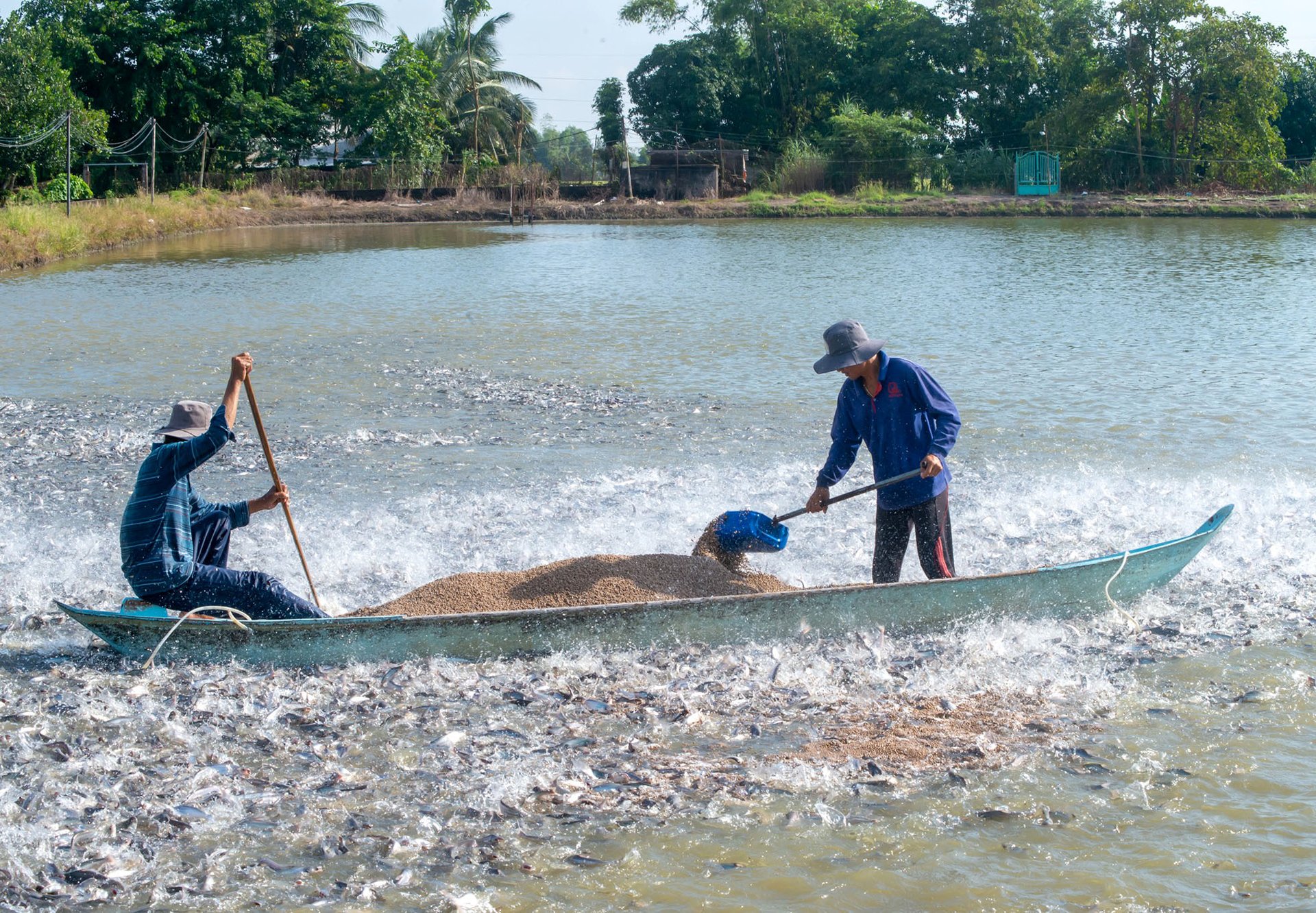November 21, 2025 | 06:12 GMT +7
November 21, 2025 | 06:12 GMT +7
Hotline: 0913.378.918
November 21, 2025 | 06:12 GMT +7
Hotline: 0913.378.918

Vietnam accounts for about 60% of the world's pangasius production. Photo: Son Trang.
During an international pangasius conference, Mr. Willemink Arno, Director of Operations at De Heus Vietnam, revealed that there is substantial potential for amplifying the export of white meat fish in general and pangasius in particular.
This potential stems from the fact that among white meat fish species, the output of naturally caught white meat fish (such as haddock, cod from the North Atlantic, etc.) cannot be further increased. Meanwhile, consumer demand remains on an upward trajectory. This presents an opportunity for aquaculture species like pangasius and tilapia to replace naturally harvested white meat fish from the oceans.
Concerning pangasius, the global total production stands at around 2 million tons, of which Vietnam accounts for 60%. Pangasius currently ranks among the two largest white meat fish species globally.
The three largest seafood import markets worldwide are currently the United States, China, and the EU. These markets also play a vital role in Vietnam's pangasius industry. In the US market, pangasius is consumed at an average rate of 1.22 kg per person per year, far exceeding other white meat fish species such as tilapia, haddock, and cod. In 2022, the US imported almost 140,000 tons of pangasius, mainly from Vietnam, with additional imports from China.
China is the world's foremost seafood producer, and exporter, and a significant market for importing pangasius products to meet consumption demands. The pangasius production in China has been increasing in recent years, reaching 263,000 tons in 2021 (a 15% increase compared to 2020). Pangasius farming in China is predominantly carried out in Sichuan, Hunan, Hubei, Henan, and Guangdong.
The growth in pangasius production in China aligns with the nation's commitment to meeting the escalating demand for seafood, both domestically and internationally. As a dynamic player in the seafood market, China not only fulfills its own consumption needs but also plays a pivotal role in the global seafood trade by importing pangasius products from other regions. This interplay of domestic production and international trade underscores China's strategic positioning as a significant player in the pangasius industry, with far-reaching implications for the global seafood market.
The import of Vietnamese pangasius to China has witnessed a rapid surge in recent years. In 2022, China imported 228,000 tons of Vietnamese pangasius, marking a 67% increase compared to the previous year. Chinese consumers are progressively incorporating this affordable protein source into their diets both at home and when dining out.

Pangasius farming in the Mekong Delta. Photo: Son Trang.
E-commerce is a driving force behind seafood consumption growth in China. Popular seafood products in e-commerce platforms include fresh and frozen shrimp, ready-to-eat seafood items, and fresh and frozen fish.
Despite the relatively low average seafood consumption per capita in Chinese cities, it is increasing rapidly. Furthermore, growth potential in rural areas and China's urbanization process offer opportunities for Pangasius to expand its market presence in the country.
In the EU, due to consumer preferences for naturally caught fish over farmed fish, pangasius consumption remains modest, averaging less than 0.3 kg per person annually. At this consumption level, pangasius does not rank among the top 15 most consumed seafood species in the EU. Nevertheless, it does feature among the top 5 most imported farmed white meat fish species.
Mr. Willemink Arno believes that the markets with the most significant growth potential for Vietnamese pangasius are China, Mexico, Thailand, and Africa. The aforementioned locations were named due to their markets displaying high demand for affordable seafood products. Consequently, the Vietnamese pangasius industry should focus on augmenting production and consumption while competing in terms of cost with other white meat fish species in the Chinese, Asian, and African markets.
For premium markets that prioritize sustainability and source traceability, such as the US and EU, processed products at reasonable prices will find opportunities. Specifically for the EU market, an improved marketing strategy is required to encourage Europeans to consume more pangasius.
According to a forecast by the FAO, by 2030, 88% of aquaculture production growth will occur in Asia, with the major farmed fish species being carp, pangasius, and tilapia. The growth of seafood consumption by 2030 will primarily take place in middle (low) income countries, accounting for 82% of consumption growth and 73% of seafood used as food.
Translated by Nguyen Hai Long

(VAN) This is the study conducted by IRRI and Can Tho University on the rice straw value chain in Mekong Delta showing an economic potential of more than 6.6 trillion VND/year.

(VAN) By participating in cooperative economics, many farmers in Tay Ninh have overcome hardship, mastered clean dragon fruit cultivation techniques.

(VAN) The crossbreeding program in the former Binh Dinh province (now part of Gia Lai) has shown signs of decline, and urgent measures are needed to revive it and sustain past achievements.

(VAN) The agricultural sector agreed on a roadmap to pilot the MRV protocol and expand low-emission rice production from the 2025-2026 winter-spring crop.

(VAN) Agricultural extension officers in Quang Ninh do more than transmit knowledge; they have become a steadfast support system for farmers on the path to sustainable agricultural development.

(VAN) The development of a high-quality beef cattle herd has brought major benefits to livestock farmers, creating jobs and enabling better use of agricultural by-products.

(VAN) In the eastern region of Gia Lai, crossbred cattle now account for 93%, forming a high-quality beef herd and establishing a recognized brand, the result of 35 years of persistent effort.